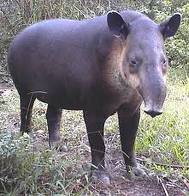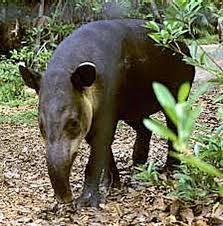 TRENT'S WALK IN THE BELIZEAN JUNGLE (Part Nine) Is brought to you by "Grand Belizean Estates" the next place to call home.  TAPIR SIGHTING Belize's national animal (or mammal), is the Baird's tapir. Locally known as the "mountain cow", but in fact this "cow" is content to live in just about any type of terrain, from bamboo thicket to mangrove swamp to rain forest, as long as a plentiful source of water is nearby. Despite its adaptability, the tapir is high on the list of the world's endangered species. Only in Belize does this shy creature still feel really at home. The tapir is the largest of all land animals indigenous to Central America. An adult weighs up to 650 lbs., its bulky body upholstered in a skin measuring between one to three centimeters thick. Still this behemoth is able to sneak quietly away on its tiptoes, or to run off boisterously on its short little legs - as fast as a man! Speaking of feet, these are specially designed for walking through mud holes, splaying out for maximum foothold in the muck and bunching up for easy extraction. The tapir has a long, flexible upper lip, which it uses for foraging and for shoveling food into its mouth. Its teeth include heavy-duty molars for crunching leaves and twigs and for crushing seed casements which require as much as 500 lbs of pressure! Another way it deals with seeds is to swallow them whole and then digest them so slowly that they germinate in the process. Fruits and vegetables are also enjoyed; the belief held by some in Belize that these herbivores will attack cattle is totally unfounded. Although it eyesight is deficient, the tapir's hearing and sense of smell are acute. Tapirs do not tend to congregate and they usually forage - day and or night - alone. A single offspring is born, ill-disguised as a fawn: brown, with white stripes and spots, which it does not lose until it is about half a year old. It will stay with its mother for another half year, by which time it will have accumulated a formidable bulk of its own. Except when a mother is protecting her youngster, tapirs tend to be wary rather than aggressive, avoiding confrontation by taking off in the other direction. In captivity they can be friendly and affectionate, as is April, the Belize Zoo's beloved tapir; every year, April's birthday is celebrated at the zoo by the children of Belie who bring her gifts of carrots and bananas.
1 Comment
|
Trenton Turley
Hi, my name is Trenton S. Turley. I've been living in Belize now for 11 years. Hope you enjoy reading my many blog posts. I write about things, that are passionate to me.
SNAKES OF BELIZE!
Check out, my my current blog series on Snakes of Belize. Categories
All
Archives
April 2016
|





 RSS Feed
RSS Feed